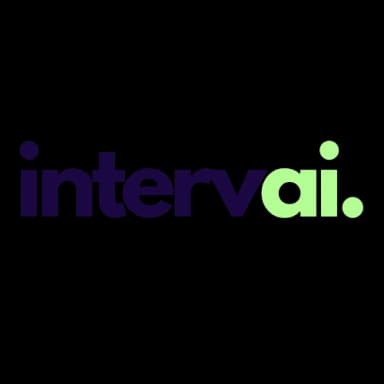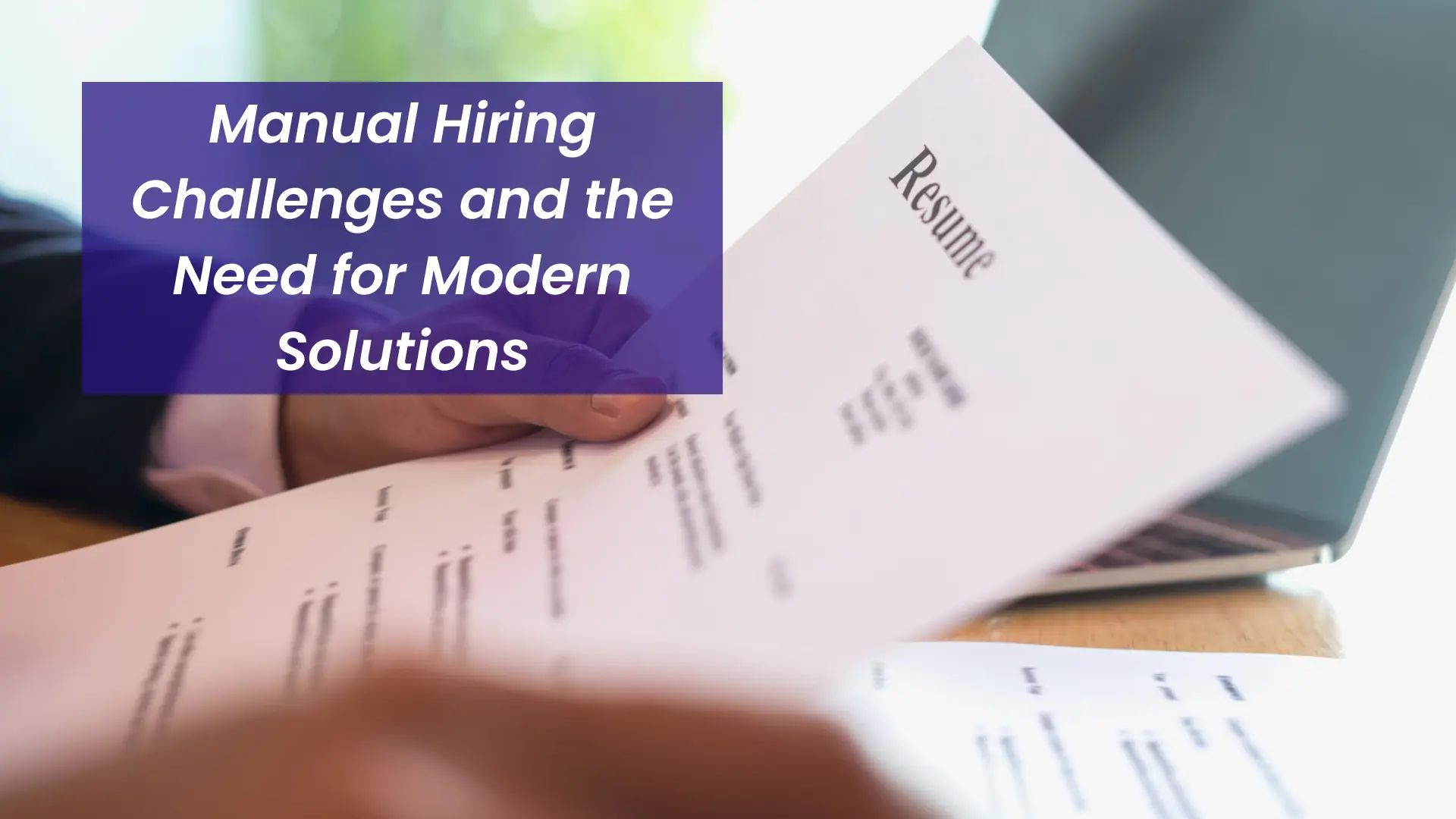The Challenges of Manual Hiring: Why It’s Time to Modernize Recruitment
In today's highly competitive job market, businesses are constantly under pressure to secure top talent effectively and efficiently. Despite the utilization of digital and AI-powered tools that promise efficiency, many companies still depend on manual hiring processes. There might be a number of reasons why these companies prefer hands-on traditional approaches, one of which is that coordinating interviews and manually screening resumes can feel familiar and safer. However, they can also be flawed. Manual hiring can be an administrative headache at times, including the costs in time and money, the risk of losing top talent, bias introduction, and, most importantly, holding back from adopting new technology and developments that could make the hiring process more efficient. In this blog post, we will explore the challenges of manual hiring, examining why they continue, how they could set back your recruitment objectives, and practical steps to incorporate automated tools into your workflow. Finally, we will explore how IntervAI, an AI-powered hiring platform, can enhance the work environment for both hiring teams and hiring managers, making it smoother and more productive.
1- The Challenges of Manual Screening
One of the most apparent problems with manual hiring is the significant amount of time it requires, as HR teams often must work with hundreds of resumes. Without automation, this screening process involves reading every resume line by line, manually sorting and ranking them, and logging candidate details into spreadsheets or applicant tracking systems by hand. Not only is this monotonous, but it's also a massive time drain. Studies routinely show that recruiters spend as much as 23 hours screening resumes for a single hire. That's valuable time they could spend interviewing top candidates, building employer branding, or refining hiring strategies.Yes, there might be ATS systems and tools available, but they typically require their form of management and still leave room for inefficiencies in the hiring process. And the cost of all this is a slow hiring process, which also likely causes candidates to accept other offers while you're still reviewing the resume pile.
2- Impacts of Human Error and Variability on Consistency
Manual hiring is very prone to errors. Even the most dynamic recruiter is susceptible to human exhaustion, attention drift, and mistakes occur. A highly qualified candidate might be overlooked due to an inconsistent scoring system or a missed keyword. Worse yet, details can get lost in translation between team members, resulting in disjointed handoffs and unclear communication.
Manual systems lack:
- Standardized evaluation criteria.
- Centralized, real-time candidate data.
- Automatic tracking of candidate stages and interactions.
Inconsistent processes aren't just inefficient—they can undermine fairness and make your company look unprofessional to candidates.
3- Unconscious Bias Emerges
A major, often-overlooked problem with manual hiring? Bias. When screening resumes and conducting interviews manually, recruiters' implicit assumptions can subtly shape their decisions. For example:
- Giving undue weight to prestigious schools (even if irrelevant to the role).
- Preferring candidates with similar backgrounds to existing team members.
- Screening out candidates with non-traditional career paths.
Without objective, structured evaluation tools, these biases can go unchecked, leading to less diverse teams and missing out on highly qualified talent. In a world where diversity and inclusion are not just values but competitive advantages, this is a significant liability.
4- Poor Candidate Experience
Today, candidates expect a quick, smooth, and transparent situation. A lot of traditional manual systems just don't meet these needs. A typical candidate career path gives us ample reason not to put ourselves in the shoes of the candidates as many get frustrated with the process. Candidates are first expected to submit their applications online, hopeful and eager to demonstrate how they can contribute to the organization. However, candidate applications are left hanging for several days or weeks with no acknowledgment of submission whatsoever. Such an attitude on the part of the organization can further augment feelings of uncertainty and frustration among candidates who have put in considerable effort when drafting their applications. When they finally get a response, they have to engage in an irritating game of back-and-forth email exchanges to schedule the interview. This coordination of schedules just becomes a frustrating barrier that only adds to the stress of candidates in any event. In truth, this long-winded scheduling process might even leave candidates wondering whether their time is being valued or if they really are just amongst so many in the queue. In fact, perhaps the most disheartening aspect of candidate experiences is the scarcity of feedback after interviews.
They hardly ever receive feedback, really meaningful or otherwise. Simple acknowledgment would go a long way.
5- Challenging Teamwork and Collaboration
Hiring is rarely a solo task. Recruiters, HR managers, department heads, and interview panels all need to weigh in on the decision. When everything is done manually—such as spreadsheets, email threads, and printed resumes—it's hard to keep everyone on the same page.
Common problems include:
- Version control nightmares with shared docs.
- Losing track of feedback in long email chains.
- Misaligned criteria between recruiters and hiring managers.
These collaboration issues slow down decision-making, create friction between teams, and risk making poor hiring choices.
6- Limited Insights and Analytics
Modern hiring isn’t just about filling roles, but about finding the right talent and fit for the role and the company. It requires continuous improvement of recruitment processes over time, but there isn’t a way to improve if you can’t measure.
- Manual hiring nearly makes it impossible to track and analyze data such as.
- Time-to-fill and time-to-hire.
- Cost per hire.
- Source of the best candidates.
- Diversity metrics.
- Candidate drop-off rates.
Without reliable data, recruitment becomes reactive and lacks solid insight, relying solely on intuition. You can't see bottlenecks, test improvements, or make strategic decisions about where to invest your hiring budget.
7- High Cost of Turnover from Bad Hires
Hiring manually increases the chance of making a bad hire:
- Essential details get missed in resume screening.
- Interviews are unstructured and subjective.
- References and background checks are rushed or skipped.
The cost of a bad hire can be substantial—up to 30% of the employee's first-year earnings, according to some estimates. Worse, a poor fit can damage team morale, client relationships, and productivity. Manual hiring processes, without structured evaluation and data support, significantly increase this risk.
8- Scaling is Painful
Yes, manual hiring can be convenient if you are filling one or two roles. But what happens when you need to hire 50 people in a month? Or open an office in a new market? Or replace key team members quickly?
Scaling manual recruitment can be your nightmare:
- More recruiters need to be hired to handle the administrative workload.
- Quality control becomes harder as volume increases.
- Bottlenecks multiply, causing delays and frustration.
Modern businesses need to be able to grow quickly and confidently. Manual processes hinder your ability to move quickly, limiting your potential for growth and confidence in your operations.
9- Compliance Risks
Hiring is subject to a host of laws and regulations:
- Data privacy (e.g., GDPR).
- Anti-discrimination requirements.
- Record-keeping and reporting obligations.
Manual systems often mean:
- Candidate data is stored in insecure spreadsheets or emails.
- Inconsistent documentation of decisions.
- Difficulty proving fair, compliant processes if challenged.
This isn't just a theoretical risk. Failing to meet compliance requirements can lead to costly lawsuits and reputational damage.
10- Burnout for Recruiting Teams
Finally, let's not forget the human side of recruiting work. Manual hiring processes are frustrating, repetitive, and draining for the recruiters themselves. Instead of doing meaningful work—like building relationships with candidates—they get buried in administrative tasks:
- Copy-pasting candidate details.
- Scheduling interviews manually.
- Chasing down feedback.
Over time, this leads to burnout, turnover among recruiting staff, and a loss of institutional knowledge, highlighting the urgent need for a more efficient and less draining hiring process.
Why Do Companies Still Hire Manually?
If the drawbacks are so apparent, why do so many companies continue to use manual hiring? There are a few common reasons:
- Familiarity: "We've always done it this way."
- Perceived cost: Fear that new tools are too expensive or complex.
- Change resistance: Stakeholders are unwilling to learn new systems.
- Lack of time: Ironically, manual hiring keeps teams so busy they feel they can't spare time to implement better systems.
But these reasons rarely hold up to scrutiny. The actual cost of manual hiring—wasted time, poor hires, and a negative candidate experience—is far higher than the cost of modernizing your approach.
The Alternative: Smarter, Automated Hiring
The good news? It doesn't have to be this way. Modern hiring platforms, powered by AI and automation, can transform recruitment:
✅ Automated Screening: Instantly score and rank resumes based on objective criteria.
✅ Centralized Data: Store all candidate information in one centralized location.
✅ Bias Reduction: Use structured evaluations to minimize subjective decisions.
✅ Improved Candidate Experience: Faster communication, easy scheduling, better transparency.
✅ Collaboration Tools: Share notes and evaluations in real time.
✅ Analytics and Reporting: Track key metrics to improve over time.
✅ Compliance Support: Maintain secure, well-documented processes.
Automating hiring doesn't mean removing the human touch—it means freeing your team from admin so they can focus on what matters most: connecting with candidates and building great teams.
Manual hiring might feel familiar and comfortable, but it's increasingly unsustainable. From wasted time and hidden bias to poor candidate experiences and compliance risks, the challenges are too significant to ignore.
Organizations that want to stay competitive need to rethink their recruitment strategies. By embracing more innovative, automated tools, they can hire better, faster, and more fairly, while giving their teams the time and insights they need to make truly strategic talent decisions.The world of work is changing. Isn't it time hiring changed, too?
IntervAI is here to transform your hiring approach if you are ready to move past the hurdles of manual hiring. Our AI-assisted platform does away with the tedious admin tasks, introduces screening bias reduction, and facilitates timely deployment of better-quality hires. From resume assessment to structured interviews, communication with candidates, and reporting to the best data-driven, stand-alone solution: IntervAI allows your team time to think strategically about human-centered hiring. Say goodbye to email clutter, missing resumes, and decisions based on gut feelings. Say hello to an automated, data-driven recruitment process that helps you secure best-in-class talent, faster. Find out more about how IntervAI can help you meet your hiring objectives at Intervai .

